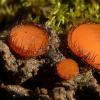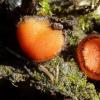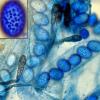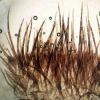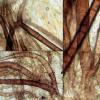
02-01-2026 17:43
MARICEL PATINOHi there, although I couldn't see the fruitbody, I

04-01-2026 17:45
 Stephen Martin Mifsud
Stephen Martin Mifsud
I was happy to find these orange asmocyetes which

03-01-2026 13:08
Niek SchrierHi all,We found groups of perithecia on a Lecanora

29-12-2025 17:44
Isabelle CharissouBonjour,J'aimerais savoir si d'autres personnes au

01-01-2026 18:35
Original loamy soil aside a artificial lake.The co

31-12-2025 19:27
Collected from loamy soil, at waterside (completel
 Hi all,
Hi all,not far away from the mysterious Octospora finding there was a Scutellinia with 5-10 mm broad fruitbodies and long, dark brown hairs, growing on very wet soil. I will give you a description of it and perhaps somebody can tell me what it can be. With Schumacher's key I came directly to Scutellinia erinaceus, which fits very well to my finding, but I do not have further literature about this specimen.
Fruitbody 5-10 mm, orangered to red, with dark brown hairs. Directly growing on the wet soil. Spores 19,5-22x13,5-15µm, broad ellipsoid, hyalin, with warty ornamentation, warts 1-1,5µm high and 2-3µm broad, often connected with small ridges, with many oil drops, thick walled. Asci with 8 spores, 230-270x20-25µm, short stalked. Paraphyses cylindrical with swollen apices; 2-3µm, tips up to 8-9µm. Hairs 800-1200µm long, thick walled, pointed, some with basal cross connections (see photos!), with 2-3 rooting hyphae, dark redbrown.
Many thanks again and regards,
kaz

In first, you can exclude definitively S. erinaceus. It's a very rare species, with a very special ornamentation, not like yours.
In fact, this is always the same problem with Schumacher's key at 16. The choice between isolated or coalescent warts with crests or ribs or not is difficult for a lot of species and, in my mind, doesn't correspond with the reality.
For me, your collection corresponds to S. "umbrorum complex". It's a complex I made to put a lot of collections with same ornementation (like yours). Perhaps, Schumacher has synonymized more than necessary around this species, and I suspect two or three species in this complex. Phylogeny and herbarium revisions are on course and I can't help more today. But, all of criteria are corresponding to this complex.
You can exclude S. patagonica and S. subhirtella for a lot of reasons.
Sorry for not proposing a final name but studies are long and I prefer progress step by step.
Cordially,
Beñat

after reading some more literature and especially some Scutellinia sp. on this forum, I also thought about a umbrorum-like specimen, and not S. erinaceus (S. erinaceus should look like S. setosa, with paler orange hymenium and setose hairs). For me, the name Scutellinia umbrorum s.l. is enough to have a base for further research and to compare with other findings.
Thank you very much for our opinion :)
regards, kaz

It's not a problem for me to give my opinion on Scutellinia, it's my personal passion ! :)
But be careful around S. erinaceus. It's not a species like S. setosa. S. setosa is probably not a Scutellinia in fact and the phylogeny confirms this specificity (and perhaps it's the same thing for sinosetosa and setosiopsis). It's necessary to wait the publication on this subject with creation of a new genus and new combinations (by phylogenic workers on this).
Per contra, S. erinaceus is a Scutellinia, really ! (I have seen the typus) but it exists a big misinterpretation in USA. A lot of american mycologists give the name "erinaceus" to typical setosa collections (on internet for example). And it's not good (you can read Schumacher's comments on S. erinaceus description in his monograph of this genus). This comes from a misunderstanding at the outset.
If you are interested by this genus, don't hesitate. You can find my mail on my profile. I'm always glad to share on this subject.
Cordially,
Beñat

that is wonderful, because I am very interested in this genus, as also in any other Pezizales. This year, I have found 6 different Scutellinia, S. setosa was one of them :)
And of course, many thanks for the help, I will send you an email if I have something interesting about the genus.
regards, kaz

Peter

If you need anything about your compilation, don't hesitate. I have made this work and I try to study all of new species.
In my opinion, species around geneospora are Scutellinia (I'm agree with Moravec) and phylogeny seems to confirm it (it's necessary to wait and have some other results). It represents three species but, personnally, I have just collections of S. geneospora from Asian continent. So, I can't say anything about totaranuensis and laevispora.
Perhaps later, but I'm on others sections now and herbarium revisions is a big work...
Beñat



